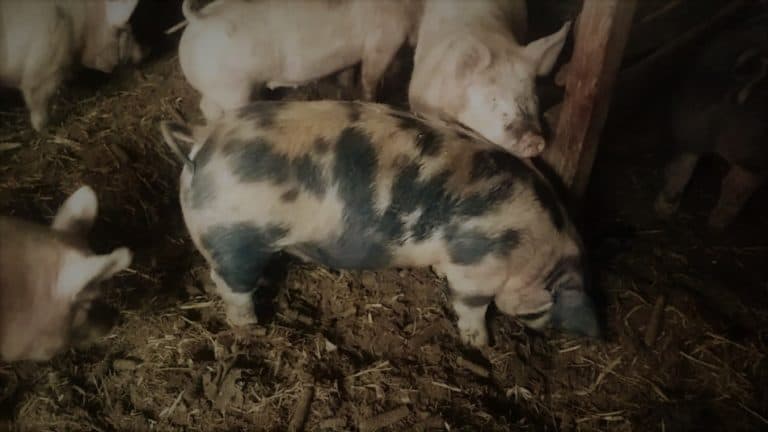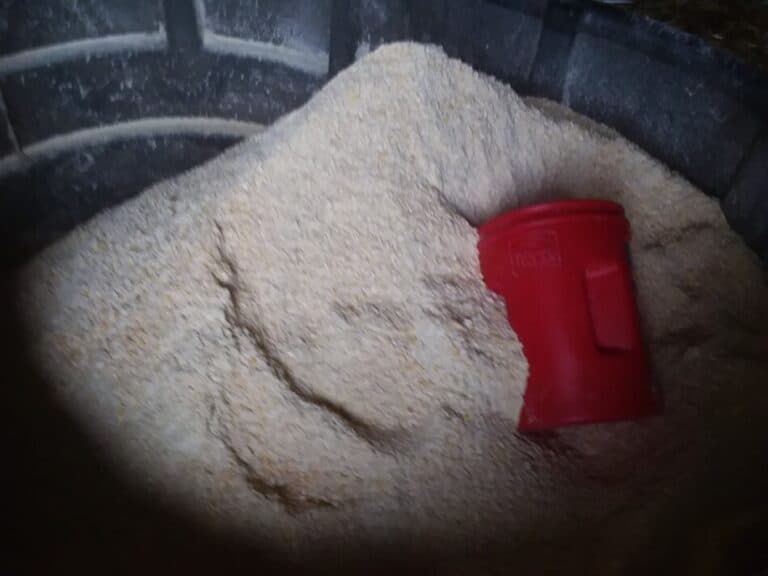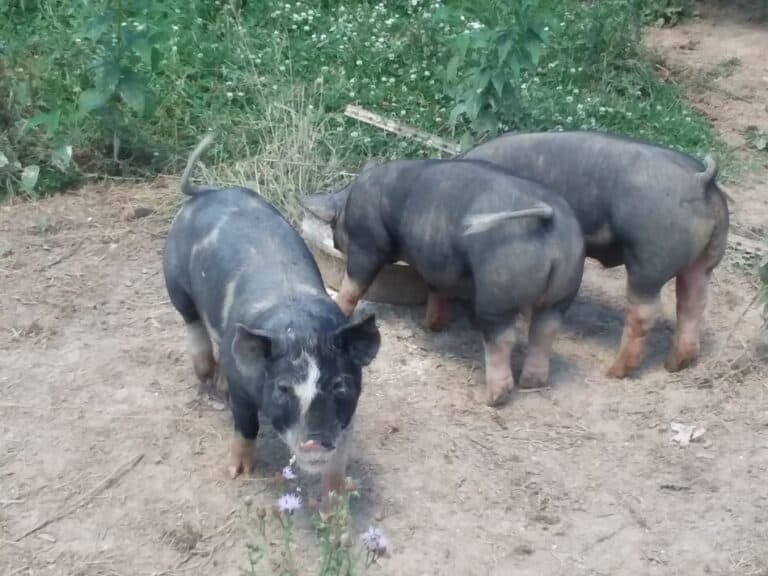When Is Your Pig Ready To Butcher? 5 Ways To Figure It Out
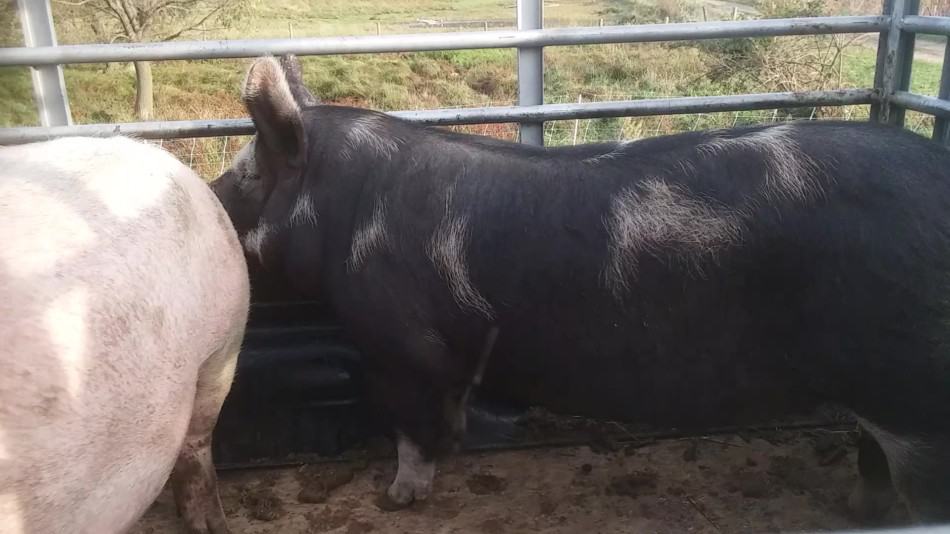
You’ve started raising a few feeder pigs and are well on your way to having a freezer full of the highest quality, wonderfully flavorful pork! Now, the big question: How do you know when those pigs are ready to butcher?
Most pigs in the U.S. would be butchered at 250-300 pounds live weight or between 6-7 months of age. Butcher ready pigs will have wide hams, flat wide backs and a double chin.
By the time your pigs get to butchering size, you will have put in months of care and feed.
Is Raising Your Own Pigs For Meat Worth It? will give you the numbers you need to budget your pig raising costs.
You want to pick the best time to butcher so that the pigs give you the meat you want, whether that is leaner or having more fat.
No worries, you have some options here.
Before we get started, please realize that there is no ideal weight for everyone. This is your pig, the ideal weight is whatever you want to feed the pig up to in order to get the results you are looking for.
There is no magic to the 250 pound finishing weight. That is just a pork industry average number for most hogs in the U.S. to be large enough and carry enough fat for the market.
I’m going to figure that you are looking for a hog with good size and plenty of fat, since fat equals flavor.
Some folks prefer a bit smaller of a pig, super! That’s why you raise your own, so you can get what you want.
Most of this information will be for finishing hogs at the higher end of usual, more like 280-300 pounds. This is the range we are aiming for with ours. We like bigger cuts and more meat.
If you are wanting leaner meat and more small family/couple sized roasts and hams, go for a lighter finishing weight like 220-230.
5 ways to tell if you pigs are ready to butcher
- Calculate the age
- Feed usage
- Visual inspection
- Weigh them
- Use weighing tape
Calculate the age of the pig
One of the easiest methods to figure out when your pigs are ready to butcher is to simply keep track of their age.
Most pigs will reach butchering size and weight at 5.5-6 months of age. This is for a 250-260 pound pig.
If you are targeting more in the 300+ pound range, allow for another month or so.
The only catch here is you need to know when they were born. If you buy your feeder pigs directly from a farmer, all of this is easy. Just ask!
| Date purchased 60 pound feeder pigs | Butcher at 250 pounds | Butcher at 300 pounds |
| April 1st | Early July | Late July to early August |
| May 1st | Early August | Late August to early September |
| June 1st | Early September | Late September to early October |
| July 1st | Early October | Late October to early November |
If you purchased your feeder pigs at an auction, then you will have to make an educated guess as to their age when you bought them.
Feeder pigs at the lighter end, more like 35-40 pounds are closer to two months old. Feeder pigs at the heavier end, around 60 pounds are closer to three months old.
Once you have a guess as to their farrowing (birth) date just count days on the calendar and pick a butchering date.
Go longer if you want a bigger, fatter pig and shorter if you are wanting leaner cuts and a bit smaller carcass.
Keep track of feed usage
This is a second way to figure a butchering date for your pigs is with another counting method. (Most people would just use the first way.)
This time you count the amount of feed consumed by your pigs. Your pigs will gain one pound of weight for every three pounds of feed eaten.
This is, of course, figuring that you have them on full feed (all they can eat, ground feed).
If you are using an alternative feeding plan, like no grain, very high vegetable or forage based rations, this method of calculation won’t help you.
For a comparison of feed choices read my article Pigs: What Are Your Feed Options.
As an example if you are planning on finishing the pigs at 250 pounds (the generic finishing weight in the U.S.) and got them at 60 pounds then here is your math.
250-60=190 pounds gain needed, per pig
Now that we know each pig needs to gain 190 pounds, we have another little bit of math to do. Remember the 3 pounds of feed to get 1 pound of gain part? That’s up next.
190 x 3=570 pounds of feed per pig to reach 250 pounds of weight
570 pounds of feed is needed to get the pigs in this example to butchering size. Before we get too locked in on that number, remember that is just a good guess.
Two things that will throw off your numbers
Two exceptions that I can think of off the top of my head are cold weather and pigs on pasture.
For the cold weather, the pigs will burn up some of the calories they eat to stay warm.
Not a ton, but they will use some to keep up their body temperature if the barn is not warmer than the frigid air outside.
The second place these calculations go wobbly on you is if your pigs are outside and running around on a pasture. They will use some of their calories to fuel horsing around instead of growth.
We had some Tamworths that loved to run all over in the pasture. Our Tamworths were nice friendly pigs that lived to exercise!
This is great for their health and happiness, but will make them need more feed than a pig that doesn’t run around all day.
Please note: you might want to figure this up anyway, so you know what you’re getting into and how much feed you’ll need for raising your pigs.
Visually inspect pigs, wide hams and double chin
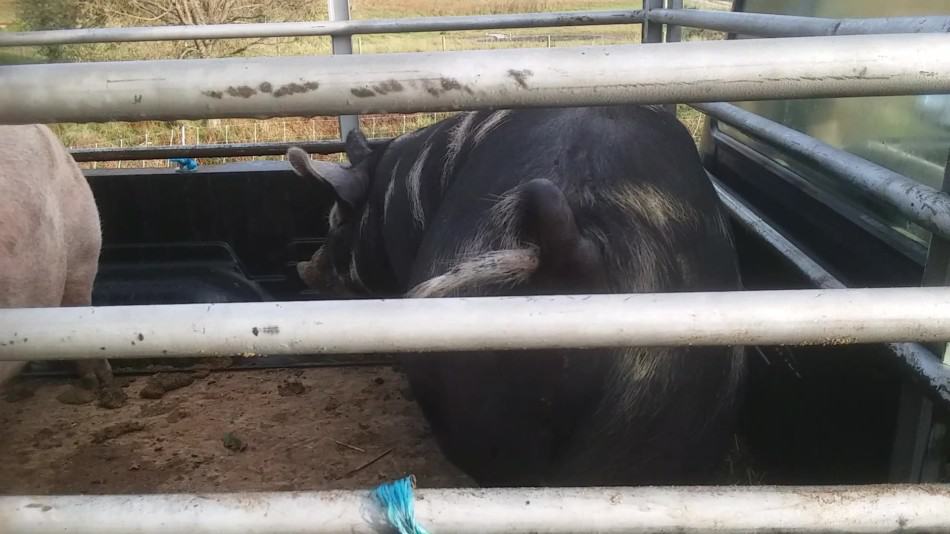
Take a good look at your pigs. Compare them to the market hogs pictured above.
How do your pigs compare? Look specifically at the wide butt and near flat back.
Now note the double chin that you can see really well on the black pig above. These are all signs that these two porkers are ready to roll.
Once you raise a few sets of pigs you’ll get much better at recognizing when a pig is finished the way you want it to be. So, how does this help you now?
Ask someone who has raised a few pigs to come look at yours in person or see if they will look at a short video-be sure to get all angles of the pig and be in good lighting.
Another option is to go visit someone with soon to be butchered hogs and take some pictures. Compare these pigs to yours.
Be sure to note the butt (hams), width of the back and fat under the chin (double chin).
When your pigs grow from nice looking pigs to “what a tank,” now you’re there!
Watch the videos that are in this article, they all show great looking market hogs that are well finished and butcher ready.
Weight the pigs on a livestock scale
You can weigh the pigs two ways-with a portable small livestock scale (a cage the pig gets locked into then their weight is taken) or you can weigh them on a truck scale.
The easiest one here is the portable livestock scale. If you can borrow one, go for it!
The next option is you can load them up in a truck or trailer and take them across a scale. This is how the grain or hay sellers get a weight on their load.
They take the truck across the scale empty then the feed mill or local grain buyer keeps that weight on file. Anytime they need the weight of their hay load, they just drive over the scale and get weighed again.
The weight of the hay is the difference between the empty weight of the truck and the weight of the truck with the hay on it.
You can do the same with your pigs, if you have a trailer or truck racks to hold the pigs.
Use weighing tape or string to weigh your pig
To calculate the pigs weight, first square the Heart Girth to get the Girth Result. Now Multiply the Girth Result by the Length and DIVIDE by 400. You now have the weight of your pig in Pounds.Mar 12, 2002
Weighing a Pig Without a Scale | The Pig Site
https://thepigsite.com › articles › weighing-a-pig-without-a-scale
You can buy a tape measure specifically made for estimating the weight of pigs or you can use a long piece of string or twine and mark the lengths then measure them against a tape measure.
The measurements you need are: 1. the heart girth-around the ribs with the tape placed just behind the front legs and 2. top line/back length-from between the ears to the base of the tail.
Once you have those two numbers you just do the math and you get an estimated weight for your pig.
The formula is (heart girth x heart girth) x top line divided by 400=pounds
Here is an example: heart girth 50 inches, top line/back 45 inches
50 x 50=2,500 2,500 x 45=112,500 divided by 400=281.25 pounds
If your pig is measuring out with the same numbers as mine (even though I just made up these numbers for the example) then you need to consider setting a butchering date pretty soon.
This pig is going to be tipping the scales at over 300 soon, very soon.
Example 2: heart girth 40 inches, top line 40 inches
40 x 40=1,600 1,600 x 40=64,000 divided by 400=160 pounds
If your pig is measuring more like this one in the second example, you have plenty of time to go. Unless, you are planning to roast a whole hog, then 160 pounds could be perfect!
For most people wanting a hog for the freezer, 160 pounds is going to be too small.
My husband used this method all of the time when he was a teenager raising market hogs.
We have always had a livestock scale, so I have never done this myself-until today.
We just measured one of our breeding gilts to see how she would react. It was, unexpectedly, quick and easy.
You should be warned: the pigs are unlikely to stand around patiently while you get their measurements.
I’m not sure why our gilt was so cooperative!
If your pigs are feeling feisty, I would try feeding them in a pan and hoping that they will be more interested in eating than wiggling around.
Be fast, that pig won’t ignore you for too long!
If we did not already have a scale, this is the method I would choose. If nothing else, I think it’s the best way for a new pig raiser to double check the finishing weight that was first determined by age.
I have to admit, I feel the measuring tape method weighed our pigs a little light. We have wide bodied pigs and using this method seems to come up 20-30 pounds short.
For longer bodied pigs, like Yorkshire or Landrace, I’d guess these numbers to be closer, for ours they were a bit off.
Close but not perfect is better than no idea, so give it a shot if you don’t have easy access to a scale.
How much meat will you get from your pig?

So you can know what you’ll likely get from your pig, here is another calculation you should consider making, especially if you have limited freezer space.
live weight hog will dress approximately 72%, thus 180 pounds of carcass. That 180 pound carcass will yield approximately 65% in retail cuts, thus approximately 120 pounds of “take home” meat. If the pig is a real lean genetic pig, the yield would be 2-5% higher; if it is a fatter pig, the yield would be somewhat less.With a 250 lb. hog live weight, how many pounds of meat approx …
livestocktrail.illinois.edu › porknet › questionDisp
The most common way to calculate how much meat you’ll get from your pig is a two step process. First take 72% of live weight=carcass weight.
Then take 65% of carcass weight=freezer meat
Keep in mind the carcass weight still includes some bones and trimmed off bits that you wouldn’t eat (that’s the reason for taking off a second percentage).
48% of pig’s live weight equals weight of meat for your freezer
I did some math to get a quicker calculation, since I’m all about easy math! If you take 48% of the live weight of your pig, you’ll get the approximate weight of pork in retail cuts.
For example: a 250 pound pig will be 120 pounds of meat in the freezer. (250 pounds x 48%=120)
Of course, this number will vary depending upon your specific cutting instructions, but 48% of live weight is a good place to start your figuring.
We just put a gilt in the freezer this week. She weighed 270 or so live and we got 123 pounds of boneless meat, packaged and in the freezer.
Granted, 123 pounds is a bit lower than you would expect, but it’s because we packaged up boneless cuts only rather than sawing out the chops or keeping the bones in the roasts.
We wanted the most meat in the smallest space, we have more pigs to put in that freezer, so we went with boneless only for this pig.
Other things to know about this pig: we butchered her here and while we are not new to home butchering, we are also not experts!
Also, we did not keep any organs, nothing wrong with them and I know they are good for you, I just don’t like eating them. If we kept all edible parts and pieces, the total packaged poundage would be higher.
Keep in mind, that if you do your own backyard butchering, you get to choose the weight of the pig. If its good for you, then go for it.
We do pigs when the weather and the finish is good for us and we have found that generally the pig has more fat than we would have guessed.
For instance, we had a group of gilts and recently chose to butcher the smallest (but healthy) one. She still had plenty of meat and fat cover, she just was smaller overall than her peers. So not great for breeding stock but just fine for the freezer.
How Much Freezer Space Do You Need For A Pig? shows you how to calculate the amount of space you’ll need and the amount of space you have free in your current freezer.



